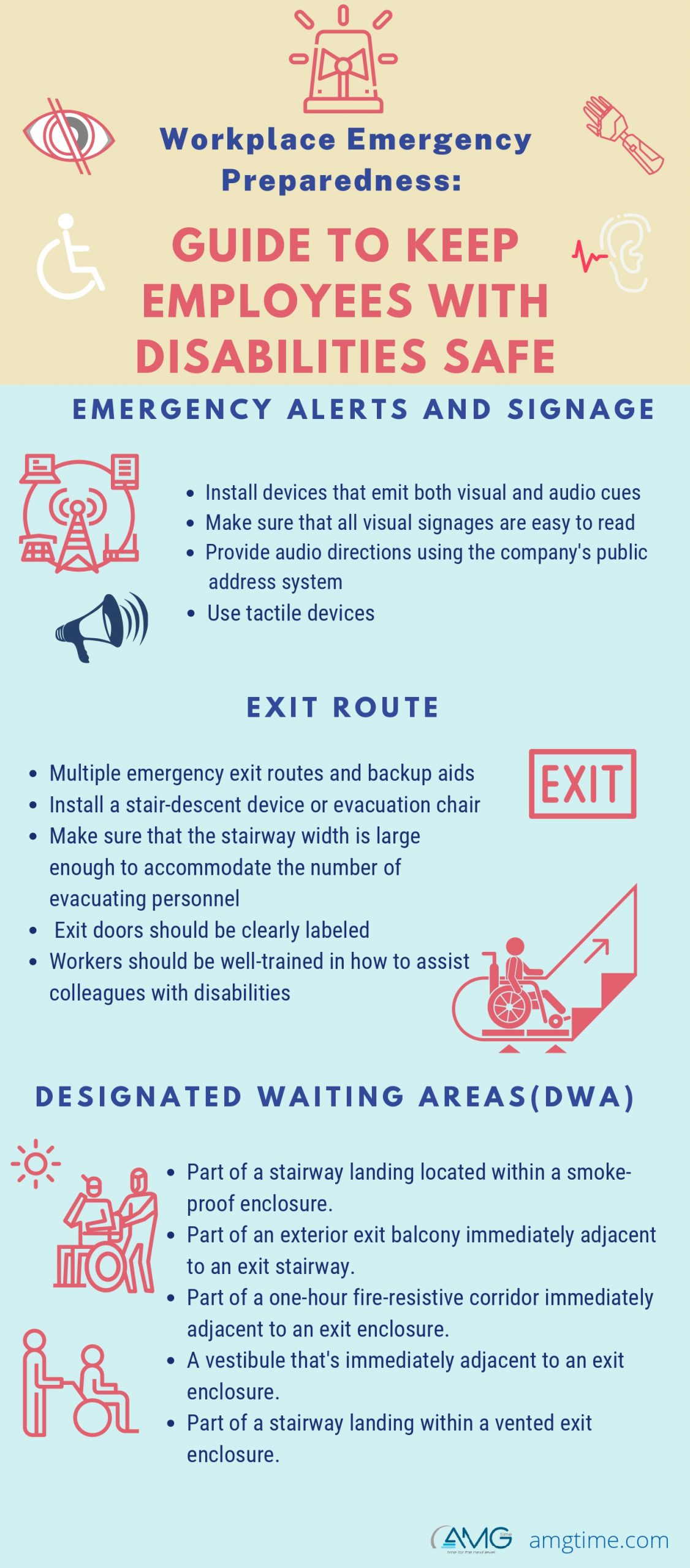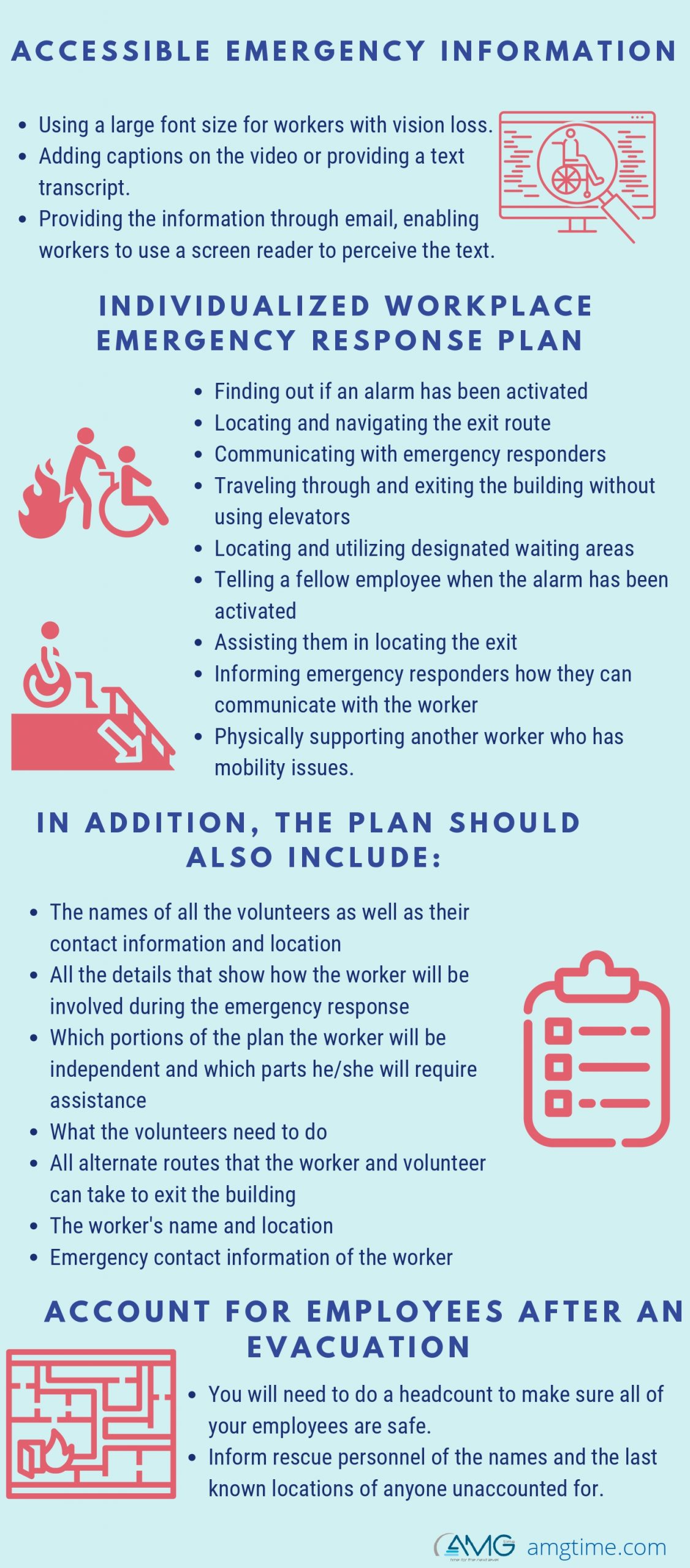

Emergencies and disasters can happen anytime, anywhere. Even in your workplace. That’s why it’s incredibly important that employers have an emergency action plan in place that all employees are aware of. An emergency preparedness action plan helps facilitate the actions of employers and workers during an emergency in the workplace. This is to reduce the number and severity of injuries to the workers and damage to the facility during the emergency. Simply put, without an emergency action plan, chaos will reign should disaster strike.
According to the OSHA (Occupational Safety and Health Administration) standards, businesses that employ more than 10 people must have a written emergency preparedness plan. Those who employ people with disabilities are required to implement special steps that will ensure their safety, and that their disabilities will not negatively impact their emergency response. Of course, this is easier said than done. This guide should help you identify the different steps you need to take to develop a well-thought-out plan that facilitates the safe evacuation of your employees that have limiting disabilities.
Building Set-Ups Adapted for Workers With Disabilities
If you have already set up action plans for emergencies that you expect to occur in your workplace, you’ll need to take the time to review your plans and their various components such as maps, alerts, exits, and designated waiting areas. You need to think about what happens during a workplace emergency. How will your workers who have disabilities be able to find out that there’s an emergency? How will they know what they need to do and where to go? More importantly, will they be able to follow the plan that you have set up?
Emergency alerts and signage
In the event of a workplace emergency, you need to make sure that all of your employees are made aware of the situation. Unfortunately, a lot of traditional methods of notification are not accessible to people with disabilities. For example, a person with a hearing impairment might have difficulty discerning an audible alert. Visual cues such as flashing lights may not work with people who have low vision or are blind.
To make sure that all of your employees get notified of the emergency, the best course of action would be to use both audio and visual cues. In addition, it’s important that your employees are aware of what these cues mean. Below are some recommendations that you can follow to make sure that emergency notifications are accessible to all:
- You can install devices that emit both visual and audio cues.
- Make sure that all visual signages are easy to read. They should contain images, large print, and good color contrast. Signages should also include Braille.
- Provide audio directions using the company’s public address system (PA system).
- Use auto-dialed text telephone (TTY) messages to send an emergency notification to pre-registered individuals.
- Use tactile devices if you have employees who are not able to perceive audio and visual alarms.
Exit route
Your emergency preparedness action plan should include escape procedures and routes. Simply put, you should plan an exit strategy if an emergency occurs. Naturally, your exit strategy must be accessible and safe for all of your employees. This means that you should plan for multiple emergency exit routes and backup aids.
For example, if your exit strategy involves the use of stairs, you run the risk of some disabled employees being unable to get out of the building. To make this exit route more accessible, you can install a stair-descent device or emergency evacuation chair. You can also make sure that the stairway width is large enough to accommodate the number of evacuating personnel. Pathways should be clear of any obstacles and well-lit. Exit doors should be clearly labeled. Moreover, your workers should be well-trained in how to assist the mobility impaired.
Designated Waiting Areas
Part of planning accessible exit strategies is to create designated waiting areas (DWA) where people with disabilities can wait safely for assistance in evacuating the area during an emergency. DWAs are typically located near an emergency exit or stairway. Take note that designated areas need to meet local regulations and codes. Below are some examples of DWAs that you can set up in your building:
- Part of a stairway landing located within a smoke-proof enclosure.
- Part of an exterior exit balcony immediately adjacent to an exit stairway.
- Part of a one-hour fire equipment services -resistive corridor immediately adjacent to an exit enclosure.
- A vestibule that’s immediately adjacent to an exit enclosure.
- Part of a stairway landing within a vented exit enclosure.
Designated waiting areas must not infringe or obstruct the exit width. It should provide a minimum of two accessible areas, each of which should measure at least 30 inches by 48 inches (horizontal surface). Moreover, there should be at least one DWA for every 200 persons.
All DWAs must have a method of two-way communication installed, enabling people and the appropriate local authority to communicate with each other during an emergency. Make sure that all DWAs have a prominent sign indicating their location. The signs need to include instructions on what people with disabilities should do to get help. Signage must also be placed at all inaccessible exits, providing people with directions to where designated waiting areas are located.
Accessible Emergency Information
It’s not enough that you create an emergency response plan for your people. You should also provide your people with emergency information. The best time to do it is during the employee onboarding process. Emergency information is defined as any visual and audio material that explains what a person should do during an emergency at the workplace.
Emergency information should be accessible. This means that all your employees, including those with disabilities, should be able to understand what they should do and where they should go during an emergency. So, how do you do that?
You need to evaluate your materials including written documents, training videos, and signs. Is there anything that would prevent a person with a disability from being able to perceive the information? For example, if a person has a visual impairment, he or she might not be able to read the emergency information you placed on a poster. A person who has difficulty hearing might not be able to understand instructions in a video. Don’t make the mistake of assuming you know best. It’s important that you ask your workers if they need the information in an accessible format.
Other ways you can make the information accessible include:
- Using a large font size for workers with vision loss.
- Adding captions on the video or providing a text transcript.
- Providing the information through email, enabling workers to use a screen reader to perceive the text.
Individualized Workplace Emergency Response Plan
Aside from ensuring that your emergency information is accessible, you also need to make sure that you take into consideration any employees who may require assistance during an emergency and choose ahead a reliable health insurance plan for employees. This involves creating an individualized workplace emergency response plan.
An individualized workplace emergency response plan is a written document that outlines all the assistance that a worker will need in the event of an emergency. For instance, during an emergency evacuation, you need to consider how employees with mobility restrictions. How will someone with crutches, walkers, or even wheelchairs be able to safely evacuate the building if the exit path is through the stairway?
An individualized workplace emergency response plan should clearly state what tasks a worker might need assistance with. Below are some examples:
- finding out if an alarm has been activated
- locating and navigating the exit route
- communicating with emergency responders
- traveling through and exiting the building without using elevators
- locating and utilizing designated waiting areas
All emergency procedures should be as accessible as possible. It’s important that employers work together with their workers to develop a plan. In addition, employers need to look for volunteers who are willing to assist fellow employees during an emergency. The type of assistance that they might need to provide include:
- telling a fellow employee when the alarm has been activated
- assisting them in locating the exit
- informing emergency responders how they can communicate with the worker
- physically supporting another worker who has mobility issues.
In addition, the plan should also include:
- the names of all the volunteers as well as their contact information and location
- all the details that show how the worker will be involved during the emergency response
- which portions of the plan the worker will be independent and which parts he/she will require assistance
- what the volunteers need to do
- all alternate routes that the worker and volunteer can take to exit the building
- the worker’s name and location
- emergency contact information of the worker
Aside from explaining how volunteers should provide assistance, the plan should include information about the mobility devices that the worker uses. It should explain how the equipment or device should be used as well as where it can be found (if it is stored).
Account for Employees After an Evacuation
Your emergency response plan doesn’t end with an evacuation. Your exit strategy should include a location where employees should gather after leaving the building. Exterior assembly areas need to be large enough to accommodate all your employees. Typically, these are located in parking lots.
Once emergency evacuation is done, you will need to do a headcount to make sure all of your employees are safe. Doing so also prevents confusion about who’s present and who’s missing which can cause a delay in rescuing people who are trapped in the building. Inform rescue personnel of the names and the last known locations of anyone unaccounted for. For this purpose, you can use the daily data of the company’s time and attendance system.
Conclusion:
You never know when an emergency will happen. It’s always best to be prepared. The safety of your employees is paramount. For this reason, it’s best to create an emergency response plan that ensures all your employees will be able to evacuate safely in the event of an emergency situation. This means identifying the accessibility barriers in your current plan and developing individualized ones for workers with disabilities.

Download the complete Infographic here:
Workplace Emergency Preparedness Guide to Keep Employees with Disabilities Safe






